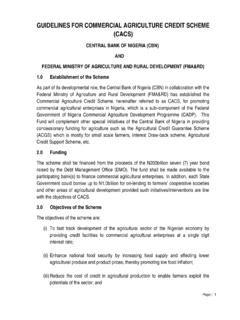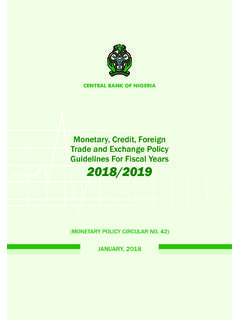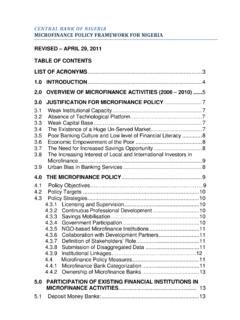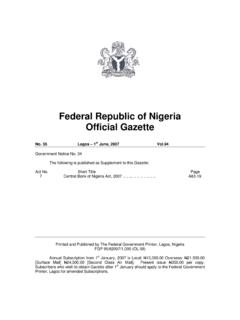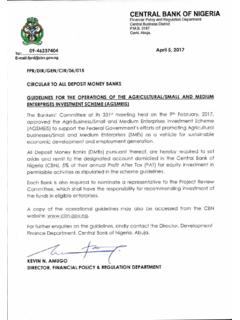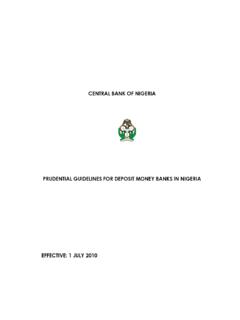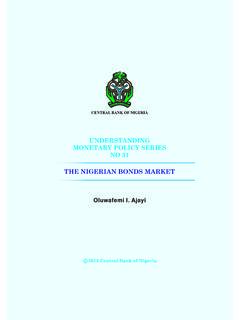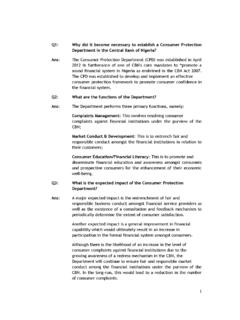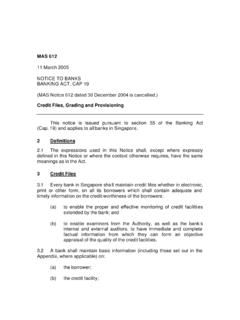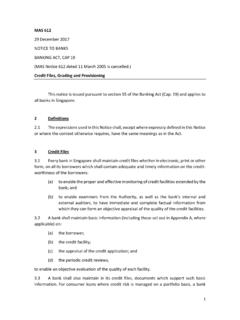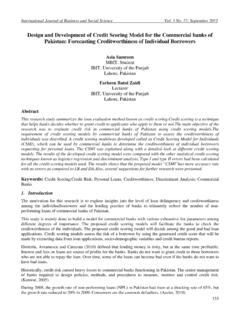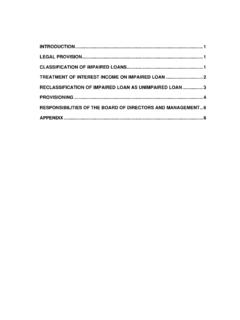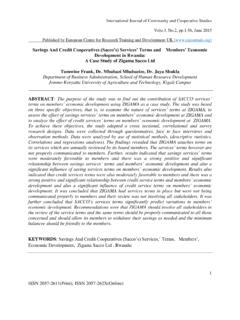Transcription of www.cbn.gov.ng
1 RISK MANAGEMENT IN FINANCIAL SERVICE INDUSTRY 1 R I S K M A N A G E M E N T I N F I N A N C I A L S E R V I C E I N D U S T R Y1 Isa Audu 2 SECTION ONE Introduction The financial service industry is dynamic as new ideas, new products and new ways of doing business are its unique features. Indeed, the businesses of financial services have changed noticeably over the years, and expanded. Amidst all this innovation, it is important to know and be able to measure the risks that new products and new ways of doing business bring. An important consequence of this shift has been an increase in the exposure to the risks associated with financial markets. The unmitigated exposure owing to expanded activities could be catastrophic for the financial system and have general spill-over (contagion) effect. The necessary complement to the development has been an increasing focus on risk management.
2 Thus, an enterprise must understand and articulate its risk appetite, not only for managing risk, but also for improving general business performance. Normally, risk is regarded as a threat to a bank s steady flow of income. The rational approach to risk therefore, is at the very least to restrict exposure to it, ideally to avoid it all together. Risk avoidance may appear as solution to every risks, but evading risk may also deny an organization the prospective gain that accepting (retaining) such risk might have permitted. This paper aims at discussing risk management in financial services industry. Following the introduction, section 2 reviews concept of risk and risk management, while section 3 discusses strategies for risk management in financial services industry.
3 Section 4 contains the overview of risk-management 1 This publication is not a product of vigorous empirical research. It is designed specifically as an educational material for enlightenment on the monetary policy of the Bank. Consequently, the Central Bank of Nigeria (CBN) does not take responsibility for the accuracy of the contents of this publication as it does not represent the official views or position of the Bank on the subject matter. 2 Isa Audu is an Assistant Director in the Monetary Policy Department, Central Bank of Nigeria. RISK MANAGEMENT IN FINANCIAL SERVICE INDUSTRY 2 practices in the Nigerian banking industry, while section 5 reviews risk management and bank regulation. Section 6 concludes the paper. RISK MANAGEMENT IN FINANCIAL SERVICE INDUSTRY 3 SECTION TWO Concept of Risk and Risk Management Risk is the possibility, likelihood or chance that something unpleasant or unwelcomed will happen that is capable of damaging an asset, or all of the original investment or the possibility of financial loss.
4 More precisely, risk is the possibility of damage or any other negative occurrence that is caused by external or internal vulnerabilities, which may be avoided through preemptive action. Risk is commonly associated with uncertainty, as the event may or may not happen. It is an essential part of business, because enterprises cannot function without taking risks as business grows through risk taking. Hence, risk is related with opportunities and threat, which may harmfully affect an action or expected outcome. Risk management is, thus, the identification, assessment, and prioritization of these risks followed by coordinated and effective application of resources to reduce, monitor, and control the probability and/or impact of disastrous events (Wikipedia 2008). It is also the process by which managers identify key risks, obtain consistent, understandable, mitigating measures, choosing which risks to avoid or reduce and by what means, and establishing procedures to monitor the resulting risk position.
5 The essence of risk management is to detect prospective problems before they become actual problem, and the implementation of an enterprises wide strategy to manage those risks. Thus, an ideal risk management program assists an enterprise to steer clear of potential risks before they occur throughout the life of the product or project. A risk management design includes tools or methods of analysis that allows an organization to reduce, delay or avoid likely risks. In its broadest sense, the risk management strategy of financial service operators is to ensure that exposure to either financial loss or loss of reputation is contained. In some areas, the objective is not to eliminate risk entirely, since it is usually necessary to take risk in order to obtain a financial return. Thus, risk management is a continuous, progressive procedure that is applied to risks that may negatively impact on a project, and there must be a balance on each project in terms of overall risk management ownership and implementation to mitigate the adverse effects of loss.
6 Risk management should address issues that could endanger the achievement of critical objectives. Risks can emanate from several ways financial markets, letdowns in project, counter party default risk, accidents, natural causes, etc. Risk RISK MANAGEMENT IN FINANCIAL SERVICE INDUSTRY 4 and risk management cut across all sectors of the economy. Risk management does not eliminate risks, but manage risks associated with firms operations, thereby exploiting opportunities and reducing threats. It also means introducing techniques to reduce the possibility of these negative events occurring, without incurring excessive costs or hampering the initiative and entrepreneurial flair of an enterprise. Hence, loss exposure is what risk management is all about, not only the ones that can be underwritten. In that regard, insurance is a method to finance some loss exposures and, thus, a part of the larger concept of managing risk.
7 The overall purpose of the management of risk process is to help a decision-maker understand a situation, along with the likely outcomes. Specifically, it helps to: o Identify the various risk elements inherent in a given system; o Prevent undue exposure to both internal (circumstances or events within an organization), or external (those in the wider business arena) risk elements that can undermine the continuous existence of a given system; o Prevent systemic failure by given early signals on any threat; o Access the quality and effectiveness of the risk management strategies already deployed to mitigate the identified risk elements in the system; o Support better decision making by providing Management with the nature of risks that may impede the organizations overall strategies and objectives; and o Develop effective strategies to manage performances and results, reinforce transparency and accountability.
8 Principles of Risk Management The International Organization for Standardization (ISO) identifies the following principles of risk management. Risk management should create value. Risk management should be integrated into the organizational processes. Risk management should be part of decision making. Risk management should explicitly address uncertainty. Risk management should be systematic and structured. Risk management should be based on the best available information. Risk management should be tailored to the specific needs of an organization. Risk management should take into account human factors. RISK MANAGEMENT IN FINANCIAL SERVICE INDUSTRY 5 Risk management should be transparent and inclusive. Risk management should be dynamic, interactive and responsive to change. Risk management should be capable of continuous improvement and enhancement. Ideal Risk Management In sound risk management practices, an ordering process is pursued, whereby those risks with the highest loss and the highest likelihood of occurring are brought under control first, and those with lesser possibility of happening and lesser loss are controlled in descending order.
9 In practice, the process can be very challenging and balancing between these probabilities can always be mismanaged. Ideal risk management can help to reduce spending as well as the adverse effects of risks. Broad Categories/Types of Risk In financial parlance, risk can be categorized into two main groups, viz., Systemic (Non-Diversifiable) and Un-systemic (Diversifiable) risk) as depicted below: a) Systemic Risk/Non-diversifiable - Systemic risk is also known as un-diversified or market risk. It can be defined as risk that cannot be eliminated or avoided by diversification; it can only be mitigated through hedging. This type of risk is uncontrollable and it is virtually impossible for any organization to protect itself from this type of risk. It cannot be planned for, as it normally arises due to the influence of external factor on enterprises.
10 Systemic risk is also macro in nature as it affects a large number of firms. Systemic risk influences a large number of assets. Interest rates, recession, war or any important political event, for example, could affect several assets in a portfolio. b) Unsystemic Risk/Diversifiable - This is the risk other than systemic risk, and sometimes referred to as "specific risk" or diversified risk. Diversifiable risk is the risk that can be eliminated by diversification. Unlike systemic risk, unsystemic risk can occur mostly as a result of internal factors prevalent in an organization. This type of risk is controllable; as such it can be planned. In effect, it is micro in nature as it affects only a particular organization. Thus, to protect business from un-systemic risk, diversification is the only solution. This class of risk affects a very small group of assets.
